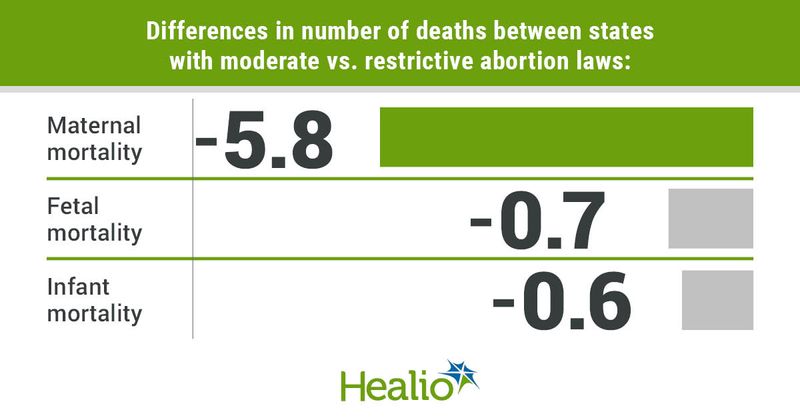Moderate state abortion laws not tied to lower all-cause mortality vs. restrictive laws
Moderate state legislation on abortion was associated with lower rates of maternal, fetal and infant mortality, but did not lower all-cause mortality, compared with restrictive laws, data published in Obstetrics & Gynecology showed.
The Supreme Court decision in Dobbs v. Jackson Women’s Health Organization is estimated to leave about 33 million women without in-state abortion services, according to study background.

“We know that limiting access to abortion increases risks for pregnant people,” Torri D. Metz, MD, MSCR, a maternal-fetal medicine specialist and co-author of the study, told Healio. “Pregnancy is a period of health risk, and for some people, pregnancy puts them at high risk of complications and death. Even among people who are otherwise healthy, pregnancy can result in life-threatening complications.”
Study design
Metz and colleagues retrospectively reviewed mortality data from the CDC Wide-ranging Online Data for Epidemiologic Research (WONDER) database to evaluate all-cause mortality among girls and women aged 15 to 49 years — deemed reproductive age — maternal mortality, fetal mortality and infant mortality.
The primary outcome was all-cause mortality and secondary outcomes were maternal, fetal and infant mortality.
Data were available from 2000 to 2019 for all measures except fetal mortality, which were available starting in 2005. Death within 1 year of life was considered infant death, and death at 20 weeks’ gestation or more was considered fetal death.
The researchers analyzed mortality rates by state with respect to the number and type of abortion laws. They used scores from the Guttmacher Institute to identify states’ overall abortion policies each year. Each restrictive and supportive policy accounted for one negative and one positive point, respectively. States scoring –6 to –2 were categorized as restrictive, those scoring –1 to 1 were moderate and those scoring 2 to 6 were supportive.
Mortality rates
The mean all-cause mortality rate among reproductive-aged girls and women ranged from 108.6 to 117.7 per 100,000 each year. There were no significant differences in the mean all-cause mortality rates across the study period or between states with varying levels of abortion restriction.
Over the study period, there was an increase in mean maternal mortality (range, 8.24-32.21 per 100,000 live births), a decrease in mean infant mortality (range, 5.7-7.1 per 1,000 live births) and no change in fetal mortality (range, 5.7-6 per 1,000 births).
Compared with restrictive states, moderate states had lower rates of maternal mortality (difference, –5.8 maternal deaths per 100,000 live births; 95% CI, –9.9 to –1.7). There was no significant difference between restrictive and supportive states.
Similarly, fetal mortality was lower in moderate (difference, –0.7 fetal deaths per 1,000 births; 95% CI, –1.2 to –0.2) but not supportive states vs. restrictive states.
Infant mortality was lower in moderate (difference, –0.6 fewer infant deaths per 1,000 live births; 95% CI, –1.1 to –0.04) and supportive (difference, –1.1 infant deaths per 1,000 live births; 95% CI, –1.6 to –0.6) states compared with restrictive states.
Maternal mortality increased with each restrictive law (1.09 maternal deaths per 100,000 live births; 95% CI, 0.36-1.82), as did infant mortality (0.2 infant deaths per 1,000 live births; 95% CI, 0.13-0.26).
Of note, trigger laws were associated with all-cause mortality, maternal mortality and infant mortality.
“This may be related to the number of other abortion restrictions already in effect and, therefore, may serve as a marker of abortion access, because all states with trigger laws are classified as restrictive states,” Metz and colleagues wrote.
Future research should investigate the impact the Dobbs decision had on mortality rates.
“This research was conducted prior to the time of the Dobbs v. Jackson Women's Health Organization decision,” Metz said. “It will be important to continue to assess the impact of laws restricting abortion on the health of women and infants moving forward. These data lend further evidence to support the idea that abortion is health care and availability of abortion is important for the health of our community.”
Editor’s note: On Nov. 28, 2022, the content of this article, including the headline, was updated to more accurately reflect the primary conclusion of the study. The editors regret the error.


